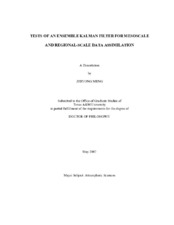| dc.contributor.advisor | Zhang, Fuqing | |
| dc.creator | Meng, Zhiyong | |
| dc.date.accessioned | 2007-09-17T19:36:06Z | |
| dc.date.available | 2007-09-17T19:36:06Z | |
| dc.date.created | 2003-05 | |
| dc.date.issued | 2007-09-17 | |
| dc.identifier.uri | https://hdl.handle.net/1969.1/5870 | |
| dc.description.abstract | This dissertation examines the performance of an ensemble Kalman filter (EnKF)
implemented in a mesoscale model in increasingly realistic contexts from under a perfect
model assumption and in the presence of significant model error with synthetic
observations to real-world data assimilation in comparison to the three-dimensional
variational (3DVar) method via both case study and month-long experiments. The EnKF
is shown to be promising for future application in operational data assimilation practice.
The EnKF with synthetic observations, which is implemented in the mesoscale
model MM5, is very effective in keeping the analysis close to the truth under the perfect
model assumption. The EnKF is most effective in reducing larger-scale errors but less
effective in reducing errors at smaller, marginally resolvable scales. In the presence of
significant model errors from physical parameterization schemes, the EnKF performs
reasonably well though sometimes it can be significantly degraded compared to its
performance under the perfect model assumption. Using a combination of different
physical parameterization schemes in the ensemble (the so-called “multi-scheme†ensemble) can significantly improve filter performance due to the resulting better
background error covariance and a smaller ensemble bias. The EnKF performs
differently for different flow regimes possibly due to scale- and flow-dependent error
growth dynamics and predictability.
Real-data (including soundings, profilers and surface observations) are assimilated
by directly comparing the EnKF and 3DVar and both are implemented in the Weather
Research and Forecasting model. A case study and month-long experiments show that
the EnKF is efficient in tracking observations in terms of both prior forecast and
posterior analysis. The EnKF performs consistently better than 3DVar for the time
period of interest due to the benefit of the EnKF from both using ensemble mean for
state estimation and using a flow-dependent background error covariance. Proper
covariance inflation and using a multi-scheme ensemble can significantly improve the
EnKF performance. Using a multi-scheme ensemble results in larger improvement in
thermodynamic variables than in other variables. The 3DVar system can benefit
substantially from using a short-term ensemble mean for state estimate. Noticeable
improvement is also achieved in 3DVar by including some flow dependence in its
background error covariance. | en |
| dc.format.extent | 41821314 bytes | en |
| dc.format.medium | electronic | en |
| dc.format.mimetype | application/pdf | |
| dc.language.iso | en_US | |
| dc.publisher | Texas A&M University | |
| dc.subject | EnKF Mesoscale | en |
| dc.title | Tests of an ensemble Kalman filter for mesoscale and regional-scale data assimilation | en |
| dc.type | Book | en |
| dc.type | Thesis | en |
| thesis.degree.department | Atmospheric Sciences | en |
| thesis.degree.discipline | Atmospheric Sciences | en |
| thesis.degree.grantor | Texas A&M University | en |
| thesis.degree.name | Doctor of Philosophy | en |
| thesis.degree.level | Doctoral | en |
| dc.contributor.committeeMember | Davis, Christopher A. | |
| dc.contributor.committeeMember | Hetland, Robert | |
| dc.contributor.committeeMember | Nielsen-Gammon, John | |
| dc.contributor.committeeMember | Shumacher, Courtney | |
| dc.type.genre | Electronic Dissertation | en |
| dc.type.material | text | en |
| dc.format.digitalOrigin | born digital | en |


